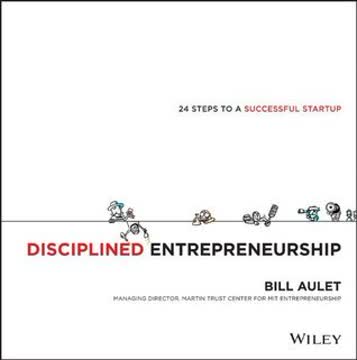Key Takeaways
1. Craft a compelling startup story to attract investors and talent
"Stories, like startups, paint a picture of what the future could be. They engage our hearts and minds. They inspire people to act—to give you money, to buy your product, to join your team."
Define your mission. Clearly articulate your company's purpose, vision, and values. This narrative should explain the problem you're solving, your unique solution, and the potential impact on customers and the market. Use tools like the Lean Canvas to structure your story and test your assumptions.
Refine your pitch. Develop separate versions of your story for different audiences:
- Investors: Focus on market opportunity, competitive advantage, and financial projections
- Employees: Emphasize company culture, growth potential, and personal impact
- Customers: Highlight the value proposition and how your product solves their problems
Evolve your narrative. Regularly update your story as your company grows and pivots. Be transparent about challenges and failures, using them to demonstrate resilience and learning. Remember, a great story isn't just about success – it's about the journey and the lessons learned along the way.
2. Build a high-performing team and foster a strong company culture
"People power. We trust and believe in our people as the foundation of success with our clients and shareholders."
Hire strategically. Look for candidates who complement your skills and share your vision. Key qualities to seek:
- Cultural fit
- Adaptability
- Passion for the mission
- Relevant expertise
Develop your team. Invest in continuous learning and growth opportunities:
- Regular feedback and performance reviews
- Mentorship programs
- Cross-functional projects
- Industry conferences and training
Create a positive culture. Establish core values and reinforce them through:
- Transparent communication
- Recognition and rewards
- Work-life balance initiatives
- Team-building activities
Remember, your company culture is a reflection of your leadership. Model the behavior you want to see in your team and be consistent in your actions and decisions.
3. Develop an effective board of directors and leverage their expertise
"If you build and manage it correctly, it can be an incredibly valuable asset to your business."
Assemble a diverse board. Seek directors with complementary skills and experiences:
- Industry experts
- Financial professionals
- Operational leaders
- Strategic thinkers
Establish clear expectations. Define roles, responsibilities, and meeting cadence:
- Regular board meetings (quarterly or monthly)
- Committee assignments (e.g., audit, compensation)
- Communication protocols
Maximize board value. Engage your directors beyond formal meetings:
- Seek advice on specific challenges
- Leverage their networks for partnerships and hiring
- Use their expertise for due diligence on major decisions
Treat your board as a strategic asset, not just a governance requirement. Foster open communication and trust, allowing for productive debates and diverse perspectives.
4. Master the art of fundraising and financial management
"The best time to look for money is when you don't need it—but not so early that a potential investor can watch your business closely for too long a period of time before the deal."
Understand funding options. Familiarize yourself with various sources of capital:
- Bootstrapping
- Angel investors
- Venture capital
- Debt financing
- Strategic partnerships
Prepare for fundraising. Develop a compelling pitch and supporting materials:
- Clear business plan and financial projections
- Detailed use of funds
- Market analysis and competitive landscape
- Team bios and track record
Manage finances prudently. Implement sound financial practices:
- Regular forecasting and budgeting
- Cash flow management
- Key performance indicator (KPI) tracking
- Cost control measures
Be strategic about when and how much to raise. Aim for a balance between having enough runway to achieve key milestones and avoiding excessive dilution. Always have a "Plan B" in case fundraising takes longer than expected.
5. Execute relentlessly and adapt quickly to market feedback
"No business plan survives first contact with customers."
Implement a lean approach. Embrace iterative development and rapid experimentation:
- Build Minimum Viable Products (MVPs)
- Gather customer feedback early and often
- Prioritize features based on user needs
Monitor key metrics. Track and analyze data to inform decision-making:
- Customer acquisition costs
- Retention rates
- Revenue growth
- User engagement
Pivot when necessary. Be willing to change course based on market realities:
- Regularly reassess your business model
- Look for new opportunities within your target market
- Don't be afraid to abandon ideas that aren't working
Execution is where the battle is won or lost. Stay focused on delivering value to your customers and be prepared to adjust your strategy as you learn more about your market.
6. Cultivate personal growth and maintain work-life balance as a CEO
"Staying fresh has always been about three related things: staying mentally fresh for work; staying healthy; and making sure I have enough time for myself that's not about work."
Prioritize self-care. Maintain physical and mental health:
- Regular exercise
- Healthy diet
- Adequate sleep
- Stress management techniques (e.g., meditation, hobbies)
Seek continuous learning. Stay intellectually stimulated:
- Read widely (business books, industry publications, general interest)
- Attend conferences and workshops
- Engage with mentors and peers
Create boundaries. Establish a sustainable work-life balance:
- Set clear working hours
- Delegate effectively
- Take regular vacations
- Nurture personal relationships
Remember that your effectiveness as a leader is directly tied to your personal well-being. Make time for activities that recharge you and provide perspective outside of work.
7. Navigate challenges and make tough decisions with confidence
"Failure is not an orphan."
Develop resilience. Cultivate a mindset that embraces challenges:
- View setbacks as learning opportunities
- Stay focused on long-term goals
- Build a support network of mentors and peers
Make data-driven decisions. Gather relevant information and analyze options:
- Seek input from team members and advisors
- Consider potential risks and contingencies
- Trust your instincts, but validate with data
Communicate transparently. Share both successes and failures with your team:
- Be honest about challenges
- Explain the rationale behind difficult decisions
- Encourage open dialogue and feedback
Leadership often requires making tough calls in the face of uncertainty. By developing a systematic approach to decision-making and learning from both successes and failures, you can navigate the challenges of startup life with greater confidence and effectiveness.
Last updated:
FAQ
What's Startup CEO about?
- Focus on CEO Experience: Startup CEO by Matt Blumberg is a practical guide for first-time CEOs, detailing the multifaceted role of leading a startup.
- Real-World Insights: It draws from Blumberg's 14 years of experience as the CEO of Return Path, providing insights into the challenges and realities of running a startup.
- Structured Approach: The book is divided into five parts, each offering actionable advice and frameworks for navigating the complexities of being a CEO.
Why should I read Startup CEO?
- Practical Guidance: Ideal for aspiring and current CEOs seeking practical advice on managing a startup.
- Learn from Mistakes: Blumberg shares his own mistakes and lessons learned, helping readers avoid common pitfalls.
- Comprehensive Coverage: Covers a wide range of topics, including hiring, company culture, financial management, and board relations.
What are the key takeaways of Startup CEO?
- Importance of Storytelling: A CEO must effectively communicate the company’s vision and mission through storytelling.
- Building a Strong Team: Hiring the best talent and fostering a positive company culture is crucial for success.
- Execution is Key: Creating a structured operating plan and maintaining financial discipline are essential for growth and sustainability.
What specific methods does Startup CEO recommend for hiring?
- Define Job Roles Clearly: Create clear and evolving job descriptions to attract the right candidates.
- Cultural Fit Matters: Hire for cultural fit alongside skills to ensure positive team dynamics.
- Involve the Team in Hiring: Engage current employees in the hiring process for better cultural alignment.
How does Startup CEO suggest managing company culture?
- Be Deliberate About Culture: Actively cultivate a positive culture that reflects the company’s values and mission.
- Foster Trust and Respect: Create an environment where employees feel valued and respected.
- Celebrate Achievements: Recognize and celebrate accomplishments to maintain morale and reinforce a culture of gratitude.
What is the Lean Canvas mentioned in Startup CEO?
- Business Model Framework: A one-page business plan template that helps startups outline their business model.
- Iterative Testing: Validate assumptions through customer feedback, allowing startups to pivot based on real market insights.
- Simplicity and Clarity: Encourages simplicity in defining a business model, making it easier for teams to align on goals.
What are the best quotes from Startup CEO and what do they mean?
- “No business plan survives first contact with customers.”: Emphasizes the need for flexibility and adaptability in a startup environment.
- “You have two ears and one mouth for a reason.”: Highlights the importance of listening more than speaking in leadership roles.
- “No one should ever be surprised to be fired.”: Reflects the necessity of clear communication regarding performance expectations.
How does Startup CEO address financial management?
- Rigorous Financial Planning: Create detailed financial projections and budgets to guide decision-making.
- Balancing Growth and Profitability: Navigate the balance between prioritizing growth versus profitability for long-term sustainability.
- Monitoring Cash Flow: Keep a close eye on cash flow to impact operational decisions and avoid potential pitfalls.
What strategies does Startup CEO suggest for effective board management?
- Building a Strong Board: Emphasizes the importance of having a well-rounded board of directors.
- Effective Communication: Maintain clear and consistent communication with board members to foster trust and alignment.
- Utilizing Board Feedback: Engage the board in discussions about strategy and performance for critical perspectives.
How can I apply the lessons from Startup CEO to my own startup?
- Implement Storytelling Techniques: Use storytelling to communicate your vision and mission to your team and stakeholders.
- Focus on Team Building: Prioritize hiring and developing a strong team that aligns with your company’s culture and values.
- Create a Structured Operating Plan: Develop a clear operating plan that outlines your strategic goals and how to achieve them.
How does Startup CEO define a BATNA?
- Best Alternative to a Negotiated Agreement: A fancy way of saying Plan B, emphasizing the importance of having alternative options in negotiations.
- Mitigating Risks: Develop a strong BATNA to mitigate risks associated with negotiations.
- Enhancing Negotiation Power: A solid BATNA enhances your negotiation power, allowing you to walk away from unfavorable terms.
What are the top strategies for financial forecasting in Startup CEO?
- Regular Reforecasting: Reforecast monthly rather than quarterly to stay agile and responsive to changing market conditions.
- Understanding Revenue and Expenses: Revenue will take longer to realize, and expenses will be higher than expected, encouraging conservative budgeting.
- Rigorous Financial Modeling: Every CEO should be able to model their business and understand its main financial drivers for informed decision-making.
Review Summary
Startup CEO receives mostly positive reviews, with readers praising its practical advice and comprehensive coverage of startup leadership challenges. Many find it valuable for both aspiring and experienced CEOs, highlighting its usefulness as a reference guide. Reviewers appreciate the author's experience and the book's actionable insights. Some critiques mention its length and focus on venture-backed startups. Overall, readers recommend it as an informative resource for understanding the complexities of running a startup and developing effective leadership skills.
Similar Books










Download PDF
Download EPUB
.epub digital book format is ideal for reading ebooks on phones, tablets, and e-readers.





